Hip & Pelvis Replacement Surgery in Mumbai

Hip Anatomy
The hip is a ball-and-socket joint formed by the thigh bone (femur) with the hip bone (pelvis). A healthy hip joint has a layer of smooth cartilage that covers the bony surfaces forming the joint to allow the ball of the femur to glide smoothly in the pelvic socket. In addition, muscles around the joint help move the joint mechanically, and you can walk without friction between the bony ends of the bones.
Functions of hip joints are:
- Leg movement
- provide dynamic support to the weight of the body/trunk
Conditions causing hip and pelvic pain:
The following conditions can lead to hip pain:
- Osteoarthritis of the hip (osteoarthrosis)
- Hip impingement
- Intertrochanteric bursitis
- Fractured hip – broken hip
- Snapping hip syndrome
- Hip dysplasia
- Osteonecrosis
Related Services
Book an Appointment
Some of the most common hip conditions:
Intertrochanteric fracture
Intertrochanteric fractures occur between the bony prominences of the femur head region called the greater and lesser trochanter. The intertrochanteric aspect of the femur is located between the greater and lesser trochanters and is composed of dense trabecular bone.
Symptoms:
- Acute onset of hip pain
- Inability to ambulate
Causes:
- Trauma and injuries of any kind can cause an intertrochanteric fracture.
Treatment:
Intertrochanteric fractures are mostly treated surgically.
The surgical treatment is suggested based on the fracture pattern and its stability. For example, fractures involving the lateral femoral wall indicate intramedullary nailing and would not be treated with a sliding hip screw. In addition, unstable fracture patterns such as fractures causing reduction of the posteromedial cortex, a thin lateral wall, displaced lesser trochanter fractures, a subtrochanteric extension of the fracture, and reverse obliquity fractures are also indications of intramedullary nailing.
Avascular Necrosis of the Femur Head
Avascular Necrosis (AVN) is known as the death of bone tissue due to decreased blood supply. It can lead to tiny breaks in the bone and cause the bone to collapse. The process is very gradual and usually takes months to years. In addition, a broken bone or dislocated joint can also stop the blood flow to a section of bone.
Symptoms:
In its early stages, AVN usually shows no symptoms, but it becomes increasingly painful. At first, it only hurts when pressure is applied to the affected bone, but, with time, it causes constant pain even without any activity.
Causes:
Things that make avascular necrosis more likely are:
- Alcohol: Multiple daily drinks can cause fat deposits to form in your blood, lowering your blood supply to your bones.
- Medical treatments: Radiation therapy for cancer has been found to weaken bones.
- Bisphosphonates: Medications that boost bone density may lead to osteonecrosis. This could be more likely if you take them for multiple myeloma or metastatic breast cancer.
- Trauma: Breaking or dislocating the hip damages nearby blood vessels and cuts the blood supply to your bones.
- Inflammation, blood clots, and damage to your arteries.
Treatment:
- Medications: If the doctor knows what's causing avascular necrosis, treatment will include efforts to manage it. While nonsurgical treatments may slow down avascular necrosis, most people eventually need surgical assistance. Surgical options include:
- Bone grafts: Removing healthy bone from one part and using it to replace the damaged bone in another area.
- Osteotomy: Cutting the bone and changing alignment to relieve stress on the joint.
- Total joint replacement: Removing the damaged joint and replacing it with a synthetic joint.
Neck of Femur fracture
A femoral neck fracture is a type of fracture at the femoral neck. When a femoral neck fracture occurs, the ball is disconnected from the rest of the femur. These fractures can completely or partially disconnect the femoral head from the rest of the femur.
symptoms:
The most common symptoms of a femoral neck fracture are:
- groin pain leading up to the fracture.
- the leg may appear shorter than the uninjured leg.
Causes:
- Trauma is the most common cause of the type of fracture.
- The medical condition that weakens bones such as osteoporosis and bone cancer.
- Falls are among the common causes of fractures.
- High-energy trauma, such as a vehicle collision.
Treatment:
- Medication: Pain medication usually provides short-term relief from pain and other symptoms. This includes over-the-counter (OTC) pain medications. In addition, your doctor may prescribe bisphosphonates to help reduce the risk of another hip fracture, depending on your age.
- Surgery: Emergency surgery is always recommended for hip fractures to manage pain and restore mobility. However, there are different types of surgeries used to treat femoral fractures. The surgery the surgeon will suggest depends on your fracture's severity, age, and underlying medical conditions.
Osteoarthritis of the hip
Osteoarthritis is a disorder of joints in which the progressive disintegration of articular cartilage occurs. In hip osteoarthritis, the cartilage in the hip joint wears off, reducing the protective space between the bones. It also becomes frayed and rough, leading to further joint damage.
Features:
- Narrowing of joint space
- Subarticular crust formation
- Sclerosis of surrounding bone
- Osteophyte formation
- Capsular fibrosis
- Bone remodeling
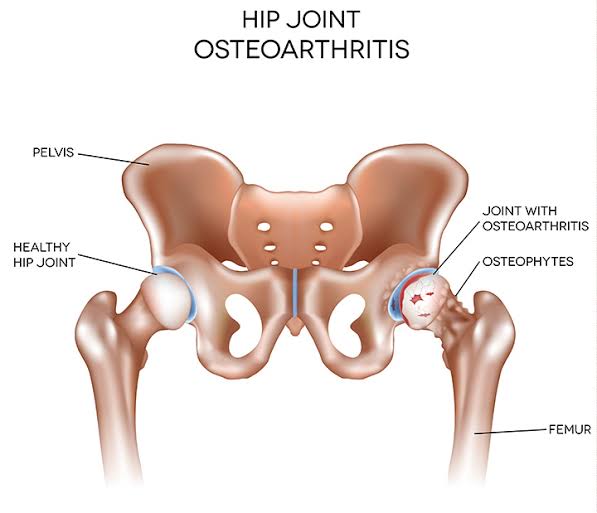
Symptoms:
- Pain in the groin or thigh
- Pain that flares up with activity
- Stiffness in the hip joint
- Decreased range of motion in the hip
Causes:
- Increasing age
- Family history of osteoarthritis
- Obesity or being overweight
- A previous injury to the hip joint
- Improper formation of the hip at birth
Treatment:
- Medications: prescription-based painkillers can be taken by consulting a doctor. It typically helps relieve mild osteoarthritis pain.
- Intra articular injections: Injections of a corticosteroid into the joint might relieve pain for a few weeks. Injections of hyaluronic acid relieve pain by providing some cushioning to the joint .
- Corticosteroid: Considered by doctors when patients are having flare-ups and are not responding to medications.
- Lifestyle changes: There are a few changes patients can make to reduce the chances of developing osteoarthritis such as:
- Weightloss
- Minimization of pain-inducing exercises
Hemiarthroplasty
Hemiarthroplasty involves a large incision over the hip bone and separating the muscle from the joint. By contrast, our surgeon uses the latest minimally-invasive technique that works only with two smaller incisions. The surgeon uses endoscopic guidance and special tools to push muscle aside instead of cutting through it. During this, either the ball or the socket part is replaced depending on the damaged part of the joint.
Total Hip Replacement (THR)
Total Hip Replacement surgery is replacing the joint with a prosthesis, which can relieve pain, improves mobility, and enable you to resume your normal activities.
During the operation, the ‘ball’ part of your femur(thigh bone) is removed and replaced with a metal ‘ball and stem’ the socket part of your hip joint is relieved with a plastic cup. Bone cement may or may not be used.
Recommended Implant Choice:
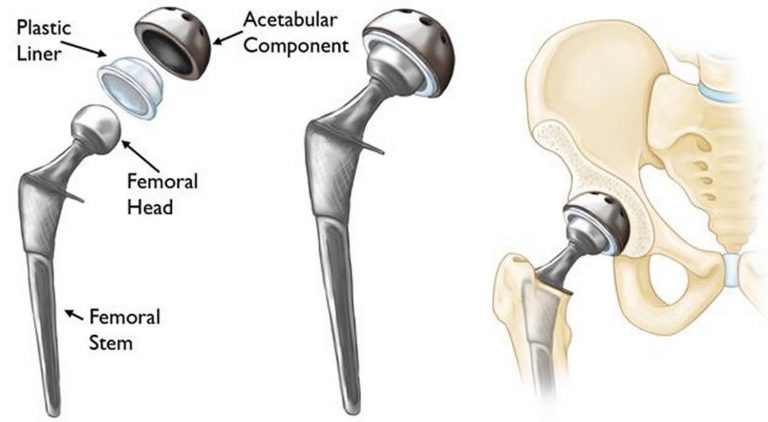
Cemented
- For elderly (>65)
- Better early
- Fixation
Cementless
- For younger people
- More active lifestyle
- Protected weight bearing first use.
- Better long-term fixation.
Surgery Steps:
- Femoral neck resection
The surgeon starts the surgery by dislocating the joint and removing the head of the femur from its socket in the pelvis. This socket is called the acetabulum. The arthritic femoral head is then cut off with a bone saw.
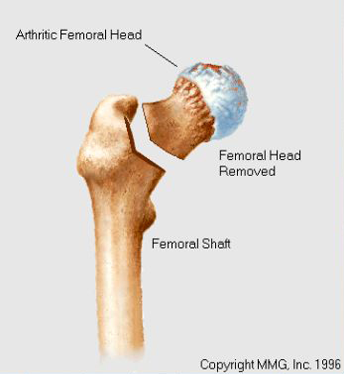
- Acetabular reaming
He prepares the acetabulum for the acetabular cup prosthesis. Next, he uses a special tool called a reamer to grind down and shape the socket.
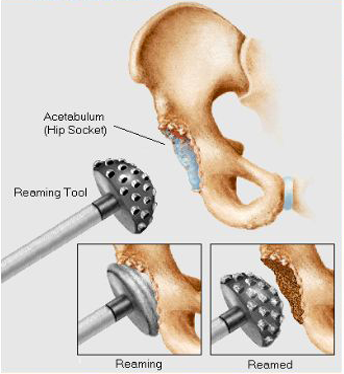
- Insertion of the acetabular component
The acetabular cup is then placed into the just reshaped socket. The cup is made of porous titanium metal, which allows the bone to grow into it over time.
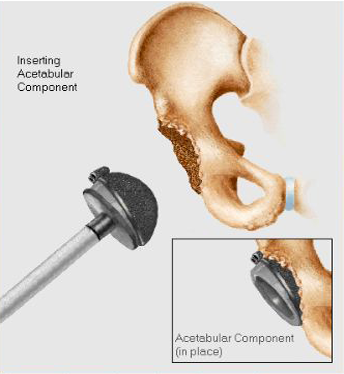
- Reaming/broaching of the femoral component
He puts a rounded acetabular liner inside the cup. It may be ceramic or plastic and facilitate smooth movement within the new joint.
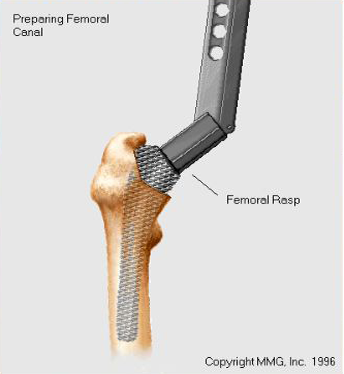
- Insertion of the femoral component
He then prepares the femur and inserts the prosthetic stem into it. The femoral stem is a narrow and tapered shaft that fits several inches inside the femur. The top is designed to hold a prosthetic ball that will replace the femoral head.
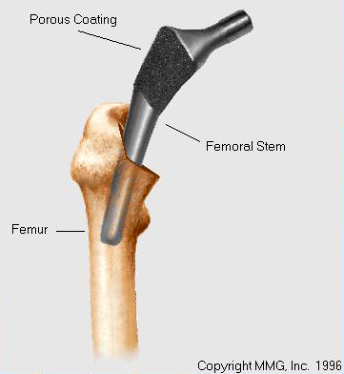
- Femoral head Impactions
A temporary prosthetic ball is then attached to the top of the stem. This ball is size-matched with the new acetabulum cup and inserted. The doctor will then insert a provisional ball into the new socket and move the hip around, checking to ensure the joint has ease of motion and does not dislocate.
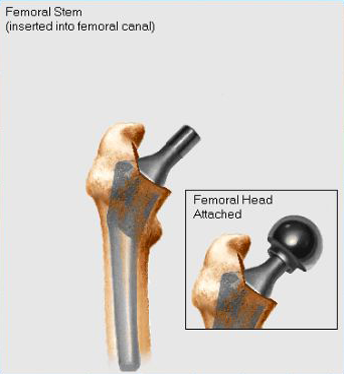
- Final implant
In the end, the doctor will remove the trial component and place the final implant, i.e., ball, into the new socket, checking again for ease of movement, the potential of dislocation, and restoration of the anatomy, including leg length.
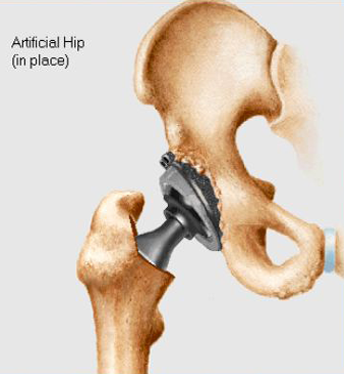
Do’s and Donts after Surgery:
DON’T
- Sit, sleep, or stand in any position that increases your discomfort
Do’s
- Follow pain-free sleep habits:
- Put a pillow between your knees if sleeping on your side for the first six weeks.
- Follow pain-free sleep habits:
- Exercise your hip 3 times daily — especially for flexibility
- Take pain control medication before exercising
- Balance your weight when standing —Do not lean to one side or the other
HIP EXERCISES
Exercises are to be done 3 times a day to improve strength and flexibility. It is your responsibility to ensure that the exercises are done. Feel free to ask for help from family or nursing if required.
HIP CARE TIPS:
- Sleep with a pillow between knees when on your side
- Bend operated leg as often as possible to reduce stiffness
- Take pain medication before beginning to exercise
- Keep the leg flat in bed without a pillow under the knee
- Start with exercises 1 — 3 day of surgery
The following exercises can be done with 10 repetitions for 3 times a day:
- With pillow between knees, bends ankles up and down
- With a pillow between knees, slowly tighten muscles on the thigh of the operated straight leg by pushing the knee down while counting to 10.
- With pillow between knees, squeeze buttock muscles together as tightly as possible while counting to 10 seconds out Mud.
- With a pillow between legs, gently roll the entire leg out and the leg into neutral so the toes are pointing up.
- With pillow between knees, bend the operated knee and pull heel toward buttocks, using cloth strap if needed to achieve full knee bend.
- With pillow between knees. Slide operated leg out to the side. Keep knee cap pointing toward the ceiling. Gently bring the leg back to the pillow.
- Place a large can or rolled towel under the operated leg. Keep knee pressed on a roll and lift the foot to straighten the leg. Use a cloth strap to assist movement if needed. Hold 5 seconds.
- Using a chair for balance if necessary, place the surgical leg back foot flat on the floor, with the forward leg bent at the knee. Slowly shift weight forward onto the front foot. Make sure the front knee DOES NOT extend past your toes. (Note: DO NOT DO IT IF YOU ARE NOT AT FULL WEIGHT-BEARING STRENGTH)
- In standing with support for balance, bend your operated hip by bringing your knee towards your chest. Do not go beyond a 90-degree bend until instructed by a Surgeon or Physiotherapist. Keep knee below the hip.
- Holding a table for balance, keep legs shoulder-width apart and toes pointed forward. Kick your operated leg out to the side, keeping your knee straight. Do not lean.
Most hip and pelvic problems start with aging due to joint overuse. Therefore, the risk of hip fracture, especially, increases with age. A hip fracture is a serious and traumatic injury with complications that can be life-threatening and require immediate expert attention. Dr. Ganesh Rajeshwar is one such expert with experience in performing more than 5000 successful surgeries for joint replacement, sports injuries, and fractures. So, if you are looking for the best hip replacement surgeon in Mumbai, book an appointment with Dr. Ganesh Immediately.

